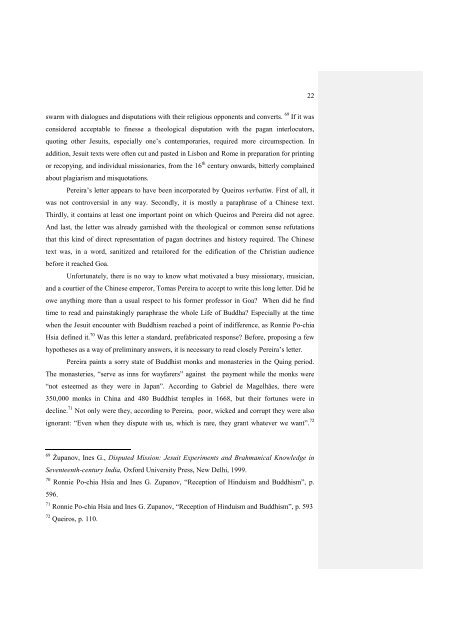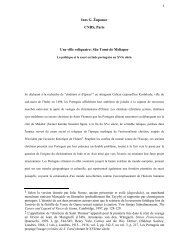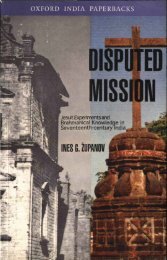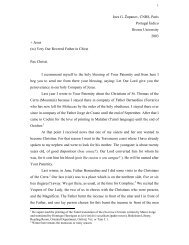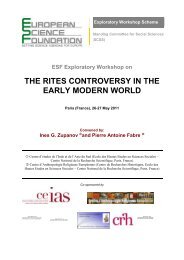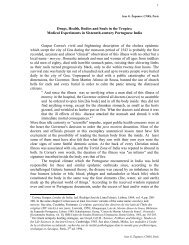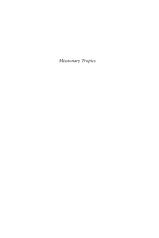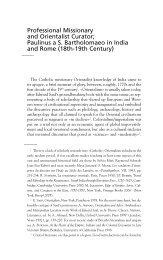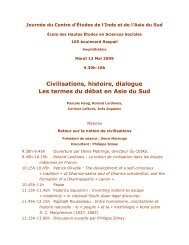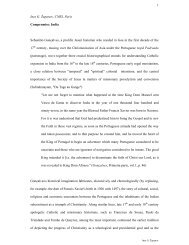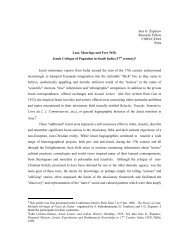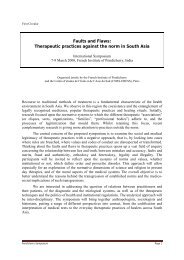Jesuit Orientalism; - Ines G. Županov
Jesuit Orientalism; - Ines G. Županov
Jesuit Orientalism; - Ines G. Županov
You also want an ePaper? Increase the reach of your titles
YUMPU automatically turns print PDFs into web optimized ePapers that Google loves.
22<br />
swarm with dialogues and disputations with their religious opponents and converts. 69 If it was<br />
considered acceptable to finesse a theological disputation with the pagan interlocutors,<br />
quoting other <strong>Jesuit</strong>s, especially one‟s contemporaries, required more circumspection. In<br />
addition, <strong>Jesuit</strong> texts were often cut and pasted in Lisbon and Rome in preparation for printing<br />
or recopying, and individual missionaries, from the 16 th century onwards, bitterly complained<br />
about plagiarism and misquotations.<br />
Pereira‟s letter appears to have been incorporated by Queiros verbatim. First of all, it<br />
was not controversial in any way. Secondly, it is mostly a paraphrase of a Chinese text.<br />
Thirdly, it contains at least one important point on which Queiros and Pereira did not agree.<br />
And last, the letter was already garnished with the theological or common sense refutations<br />
that this kind of direct representation of pagan doctrines and history required. The Chinese<br />
text was, in a word, sanitized and retailored for the edification of the Christian audience<br />
before it reached Goa.<br />
Unfortunately, there is no way to know what motivated a busy missionary, musician,<br />
and a courtier of the Chinese emperor, Tomas Pereira to accept to write this long letter. Did he<br />
owe anything more than a usual respect to his former professor in Goa? When did he find<br />
time to read and painstakingly paraphrase the whole Life of Buddha? Especially at the time<br />
when the <strong>Jesuit</strong> encounter with Buddhism reached a point of indifference, as Ronnie Po-chia<br />
Hsia defined it. 70 Was this letter a standard, prefabricated response? Before, proposing a few<br />
hypotheses as a way of preliminary answers, it is necessary to read closely Pereira‟s letter.<br />
Pereira paints a sorry state of Buddhist monks and monasteries in the Quing period.<br />
The monasteries, “serve as inns for wayfarers” against the payment while the monks were<br />
“not esteemed as they were in Japan”. According to Gabriel de Magelhães, there were<br />
350,000 monks in China and 480 Buddhist temples in 1668, but their fortunes were in<br />
decline. 71 Not only were they, according to Pereira, poor, wicked and corrupt they were also<br />
ignorant: “Even when they dispute with us, which is rare, they grant whatever we want”. 72<br />
69 <strong>Županov</strong>, <strong>Ines</strong> G., Disputed Mission: <strong>Jesuit</strong> Experiments and Brahmanical Knowledge in<br />
Seventeenth-century India, Oxford University Press, New Delhi, 1999.<br />
70 Ronnie Po-chia Hsia and <strong>Ines</strong> G. Zupanov, “Reception of Hinduism and Buddhism”, p.<br />
596.<br />
71 Ronnie Po-chia Hsia and <strong>Ines</strong> G. Zupanov, “Reception of Hinduism and Buddhism”, p. 593<br />
72 Queiros, p. 110.


